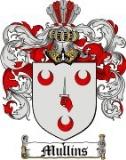Life History
1689 |
Born in St George Parish, Kent, England.1 |
16th Mar 1709 |
Married Margaret MANLEY in Maidstone, Kent, England.1 |
1714 |
Birth of son Thomas MULLINS in Gravesend, St George Parish, Kent, England.2,3,4,5 |
Feb 1733 |
Died in Kent, England.1,2 |
Notes
- Like many prominent lineages of Ireland, the Mullins line has Norman connections and perhaps origins. The "Anglo-Irish" were really Anglo-Normans, associated with the Norman nobility who supported William the Conqueror when he invaded England in 1066 to claim the crown of the Anglo-Saxons.
Ireland was a hard land to tame, and concerted efforts really made headway under King Edward I, who was also trying to subdue the Scots, by coercion, bribery, military and political repressions and terror. The era of Robert the Bruce engaged King Edward with a resurgence of Scottish revolt.
The Anglo-Norman Irish gradually melded into the Irish cultural and genetic landscape of the native Celtic nobility they married into, becoming more Irish in culture and temperament than Norman or English. The following writeup by another genealogist presents an excellent summary of possible origins of the Mullins name and lineage and some pertinent points from history.
==========================
Surname: Mullins
There are two accepted sources for this surname when found in Ireland. The first is as an Anglicized form of the Old Gaelic "O'Maolain," a byname which translates as "the descendant of the tonsured one," indicating perhaps a devotee or follower of an unspecified saint. Alternatively, the byname may refer simply to one who looked like a monk or who had monkish qualities.
The second source is Anglo-Norman: Mullins in this instance being a development of the French "moulin," meaning "mill," and denoting one who was resident at such a place. The pointer to this second source may be contained within the Coat of Arms which includes a gold cross moline on a blue field.
Whether of Gaelic or Anglo-Norman origins, nameholders have regularly made their mark in history, James Mullins of Dublin (1721-1776) being a Royal Academician and landscape painter of international repute, whilst earlier in 1658, Robert and George Mullins, of Taunton in England, were convicted of being "Monmouth rebels," and were deported to the West Indies as slaves. Nearly as unfortunate was James Mullins of Newry, County Down, who was a famine emigrant on the ship "Robinson" bound for New York in May 1847.
Examples of name recordings are those of Daniel Mullins of Ballyhay, County Cork, on October 4th 1796, and James Mullins of Palmerston District, Dublin, on July 8th 1865. The first recorded spelling of the family name is shown to be that of Joseph Moline, which was dated November 16th 1658, a witness at Derry Cathedral, during the reign of Richard Cromwell, known as "The Lord Protector," 1658 1659. Surnames became necessary when governments introduced personal taxation. In England this was known as Poll Tax.
Throughout the centuries, surnames in every country have continued to "develop" often leading to astonishing variants of the original spelling. There are three O'Maolian septs, one located in County Galway, one in the counties of Derry and Tyrone, and a third in County Cork. The maritime county of Cork, in Munster, is bounded by the sea on the south-west, the south and the south-east.
To the east it has land boundaries with the counties of Waterford and Tipperary, and to the north with Limerick and to the west with Kerry. Anciently the country formed part of the kingdom of Desmond. After the Anglo-Norman Invasion the whole of the present county, save the City of Cork (which had been founded by the Vikings) and its surroundings, was granted in 1177 by Henry II to Anglo-Norman knights who brought over their followers and established a military colony.
They all provide the ancestry of families called Mullin, Mullen, Millen, Mulhane and Mulhane. The name was derived from the Gaelic O'Maolain, and the name is now widespread in all provinces, predominantly found in Ulster. Early records of the name mention Ralph de Molins, 1159 Ireland. When the sparse Irish population began to increase it became necessary to broaden the base of personal identification by moving from single names to a more definite nomenclature.
The prefix MAC was given to the father's Christian name, or O to that of a grandfather or even earlier ancestor. At first the coat of arms was a practical matter which served a function on the battlefield and in tournaments. With his helmet covering his face and armour encasing the knight from head to foot, the only means of identification for his followers, was the insignia painted on his shield and embroidered on his surcoat, the draped and flowing garment worn over the armour.
The name was also occasionally used as an occupational name from the Anglo-French 'moulin' meaning one who lived or worked by a mill. The mill, whether powered by water, wind or occasionally) animals, was an important centre in every medieval settlement; it was normally operated by an agent of the local landowner, and individual peasants were compelled to come to him to have their corn ground into flour, a proportion of the ground corn being kept by the miller by way of payment.
-- Ancestry Tree Stories, http://trees.ancestry.com/pt/ViewPhoto.aspx?tid=200440&pid=-842030936&iid=664b3859-99e7-48f9-aa71-99a0c3177925&src=search
==========================
The folloiwng family genealogy provide details about Edward Mullins.
Edward Mullins
Birth 1689 in St George Parish, Kent, England
Death Feb 1733 in County, Kent, England
Marriage 16 Mar 1709 to Margaret Manley, born 1691 in Maidstone, Kent, England
Son Thomas Mullins
Birth 1714 in St George Parish, Kent, England
Death 1760 in Granville, Granville, North Carolina
-- Burgess Family Tree, http://trees.ancestry.com/tree/9735530/person/-589738322?ssrc=&ftm=1
Page created using GEDmill 1.11.0



